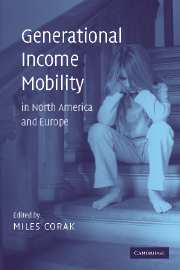Book contents
- Frontmatter
- Contents
- List of figures
- List of tables
- List of contributors
- Preface
- 1 Generational income mobility in North America and Europe: an introduction
- 2 A model of intergenerational mobility variation over time and place
- 3 Equal opportunity and intergenerational mobility: going beyond intergenerational income transition matrices
- 4 Intergenerational mobility for whom? The experience of high- and low-earning sons in international perspective
- 5 What do trends in the intergenerational economic mobility of sons and daughters in the United States mean?
- 6 Changes in intergenerational mobility in Britain
- 7 Intergenerational mobility in Britain: new evidence from the British Household Panel Survey
- 8 Non-linear patterns of intergenerational mobility in Germany and the United States
- 9 Family structure and labor market success: the influence of siblings and birth order on the earnings of young adults in Norway, Finland, and Sweden
- 10 New evidence on the intergenerational correlation in welfare participation
- 11 Intergenerational influences on the receipt of unemployment insurance in Canada and Sweden
- 12 Unequal opportunities and the mechanisms of social inheritance
- Index
- References
12 - Unequal opportunities and the mechanisms of social inheritance
Published online by Cambridge University Press: 22 September 2009
- Frontmatter
- Contents
- List of figures
- List of tables
- List of contributors
- Preface
- 1 Generational income mobility in North America and Europe: an introduction
- 2 A model of intergenerational mobility variation over time and place
- 3 Equal opportunity and intergenerational mobility: going beyond intergenerational income transition matrices
- 4 Intergenerational mobility for whom? The experience of high- and low-earning sons in international perspective
- 5 What do trends in the intergenerational economic mobility of sons and daughters in the United States mean?
- 6 Changes in intergenerational mobility in Britain
- 7 Intergenerational mobility in Britain: new evidence from the British Household Panel Survey
- 8 Non-linear patterns of intergenerational mobility in Germany and the United States
- 9 Family structure and labor market success: the influence of siblings and birth order on the earnings of young adults in Norway, Finland, and Sweden
- 10 New evidence on the intergenerational correlation in welfare participation
- 11 Intergenerational influences on the receipt of unemployment insurance in Canada and Sweden
- 12 Unequal opportunities and the mechanisms of social inheritance
- Index
- References
Summary
Ideology and myth do not die easily, and certainly not at the hands of social scientists. Even with decades of systematic and cumulative social scientific evidence to the contrary, in many public policy circles it is still widely believed that North Americans and Europeans live in the land of equal opportunities. Yet the evidence, including the chapters of this book, demonstrates that, notwithstanding a half century of educational expansion and social reform, life chances remain powerfully determined by social origins. This is certainly worrisome if policy makers care about social justice, but it is also problematic if they are concerned with the future. If a large share of today's youth fails to realize its full productive potential, tomorrow's retirees will be less well off.
In this chapter, I shall try to bring together what sociologists and economists know, or at least need to know, about social inheritance and life chances. The bad news is that the constancy of social inheritance dominates our findings. The good news is that recent research has uncovered instances in which it has diminished importantly. If we can identify the precise mechanisms at work this might help governments devise policies to more effectively ensure equal opportunities. To anticipate my conclusions I am, first of all, sceptical of the usual assumption that generational inheritance is primarily driven by investments in education.
- Type
- Chapter
- Information
- Generational Income Mobility in North America and Europe , pp. 289 - 314Publisher: Cambridge University PressPrint publication year: 2004
References
- 14
- Cited by



